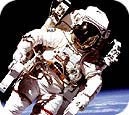Science in Focus: John Wilson
"To Know the Universe"
Well, sort of.Editor's Note: This piece is a golden oldie, first posted on the Christianity Today website in February 2000. I came across a printout of it last weekend—along with the issue of Natural History magazine referenced therein—while engaged in the Sisyphean task of sorting through piles of stuff at home, trying to weed out what I can. One footnote: Very soon after this piece was posted, I did indeed have a chance to visit the Rose Center for Earth and Space, along with our youngest daughter, Katy, who was then 15 years old.
One of the recurring themes in the screeds that followed the Kansas State Board of Education decision last year was that this decision revealed a much more pervasive problem: a widespread "anti-science" attitude among the American people. Oh, really? A visiting Martian would get a very different impression from the huge media coverage (magazines, newspapers, television, National Public Radio: you name it) given to the $210 million Rose Center for Earth and Space at the American Museum of Natural History in Manhattan, including the completely revamped Hayden Planetarium.

"Fueled by a national obsession with all things scientific," Natasha Singer wrote in the February 21 issue of New York magazine, "the Museum of Natural History is about to launch the world's most advanced planetarium and the stunning new Rose Center for Earth and Space." On February 19, the day the center opened to the public, the New York Times reported that the attraction was expected to draw 4.5 million visitors a year. (That anti-science attitude is everywhere, isn't it?)
And what will those 4.5 million visitors—our Martian incognito among them—find when they enter this temple of science? To get an idea, check out the February issue of Natural History, the superbly produced magazine of the American Museum of Natural History. This is a special issue titled "To Know the Universe." It features an introduction by Ellen Futter, president of the museum and the driving force behind this project, who says that "together with our beloved exhibition halls, the Rose Center will enable the Museum to take visitors on a grand and all-encompassing journey that tells a coherent, comprehensive story of life, from the outer reaches of the universe to the planet's inner core and through the extraordinary diversity of life and culture on Earth." Futter's introduction is titled "A Seamless Vision."
The issue is devoted to fleshing out those remarkable claims. Many of the contributors are prominent scientists—Allan Sandage, Margaret Geller, Alan Guth, and Brian Greene, for example—and all of them are gifted communicators. Neil de Grasse Tyson, the director of the Hayden Planetarium, contributes two essays. And among the magazine's regular departments there is Stephen Jay Gould's column, which picks up the issue's special theme; his essay is titled "What Does the Dreaded 'E' Word Mean, Anyway? A Reverie for the Opening of the New Hayden Planetarium."
So what is the story these pieces collectively tell? Start with a callout quote from Gould's essay: "Many people cling to the comforting view that human consciousness must represent a predictable (if not divinely intended) summit of biological existence." Flip a few pages over to a description of the way the new planetarium seeks to convey "the size and scale of objects in the universe." Are you beginning to get the picture?
Here's Edward Rothstein's account in the New York Times (February 19):
If Copernicus and Galileo showed that humanity is not at the center of the universe, here humanity is not even at the center of the planetarium. The planetarium is not an attempt to project the human imagination outward, giving shape to the heavens, but an attempt to project that cosmos inward, imprinting it on the human imagination, stupefying it. The allusions to myth [in the old Hayden Planetarium], the city buildings at night, the view of the stars from earth's reference point—all this has been put aside. Instead of bringing the cosmos home, the home has been thrust, untethered, into the cosmos.
I am looking forward to visiting the museum at the first opportunity. I am sure there will be much to learn, and much occasion for wonder. But I don't expect to take from it the story that its makers seem to have intended.
John Wilson is the editor of Books & Culture.
Copyright © 2013 Books & Culture. Click for reprint information.








Displaying 0–0 of 0 comments.
Displaying 0–0 of 0 comments.
*